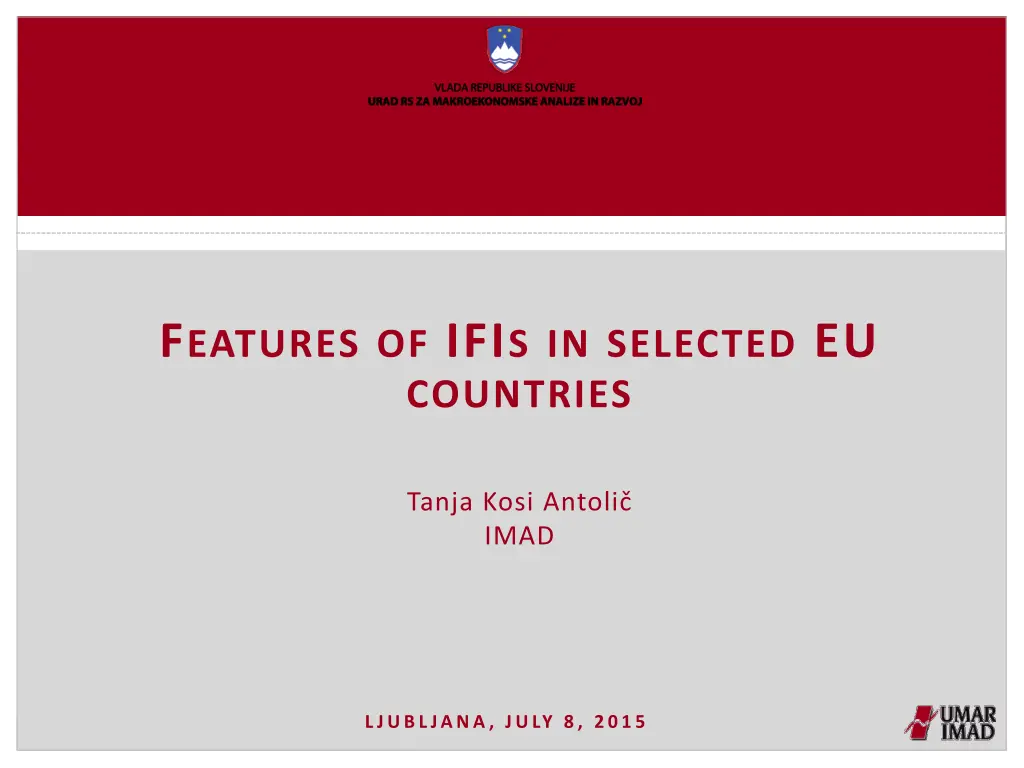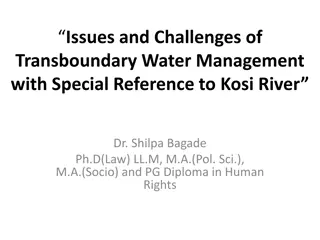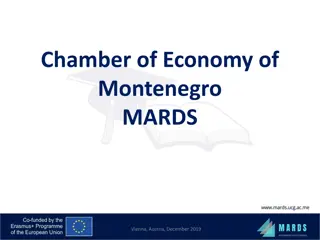
Features of IFIs in Selected EU Countries Revealed
Explore the diverse landscape of Independent Fiscal Institutions (IFIs) in various EU nations, highlighting the recent strengthening of the EU fiscal framework and the varying structures of IFIs across countries. Learn about the mandates and roles of Fiscal Councils in monitoring compliance with fiscal rules and enhancing transparency in economic forecasts.
Download Presentation

Please find below an Image/Link to download the presentation.
The content on the website is provided AS IS for your information and personal use only. It may not be sold, licensed, or shared on other websites without obtaining consent from the author. If you encounter any issues during the download, it is possible that the publisher has removed the file from their server.
You are allowed to download the files provided on this website for personal or commercial use, subject to the condition that they are used lawfully. All files are the property of their respective owners.
The content on the website is provided AS IS for your information and personal use only. It may not be sold, licensed, or shared on other websites without obtaining consent from the author.
E N D
Presentation Transcript
FEATURES OF IFIS IN SELECTED EU COUNTRIES Tanja Kosi Antoli IMAD LJUBLJANA, JULY 8, 2015
The recently strengthened EU fiscal framework has increased the minimum requirements for the national fiscal frameworks, including independent fiscal institutions (IFIs) EU Fiscal (Governance) Framework European Commission & EU Council EU Fiscal Rules (EU legislation & Fiscal Compact) Fiscal Councils & other Independent Fiscal Institutions National Fiscal Rules National Fiscal Framework
The number and features of IFIs differ across EU countries... BE UK BG SE CZ FI DK SK DE SI EE RO IE EU FISCAL FRAMEWORK PT EL PL ES AT FR NL HR MT IT HU CY LU LV LT
IFIS IN SELECTED EU COUNTRIES SK AT EU FISCAL FRAMEWORK Council for Budget Responsibility Macroec. forecasting committee Tax Revenue Forecasts Committee Fiscal Council WIFO Parliamentary Budget Office (PBO) DE NL Stability Council Joint Econ. Forecast (JEF) Project Team Working Party on Tax Revenue Forecasting Advisory Board to the Federal MF German Council of Economic Experts Council of State CPB Advisory Group on Fiscal Policy Working Groups on Spending Reviews The Tax System Study Committe BE LV High Council of Finance FPB (NAI) Fiscal Discipline Council
FISCAL COUNCILS (FC) IN SELECTED EU COUNTRIES EU FISCAL FRAMEWORK SK AT Council for Budget Responsibility (2012) Fiscal Council, (2013/1970) NL BE LV DE Council of State (16c) Advisory Division (2014) in cooperation with CPB High Council of Finance (1936/1989) Stability Council (2010) Advisory Board (2013) Fiscal Discipline Council (2014)
MANDATE OF FISCAL COUNCILS /1 Tasks of IFIs foreseen by the EU legislation and Fiscal Compact: Effective and timely monitoring of compliance with fiscal rules all 6 CTRs Monitoring and assessment of a corrective mechanism all 6 CTRs Increasing transparency and communication with the public all 6 CTRs Production or endorsement of macroeconomic forecasts Production by another IFI: AT (WIFO), BE (FPB), NL (CPB), DE (JEF only for DBP) Non-binding assessment by FC: LV Endorsement by another IFI: SK (Macroeconomic Forecasting Committee)
MANDATEOFFISCALCOUNCILS /2 Other tasks: Surveillance of subnational governments (DE) Analysis of long-term fiscal sustainability (AT, BE, SK, NL-CPB) Analysis of the quality of public finances (AT) Identification of fiscal policy options and formulation of recommendations (AT, BE, DE) Policy costing (SK, NL-CPB, AT-Parliamentary Budget Office)
ORGANIZATION AND FINANCING OF FISCAL COUNCILS AT BE NL DE SK LV Stand-alone (separate budget) (financed by federal & state governments) - - - Federal Public Service Finance (executive) Attached to other institution Central bank Council of State Central bank
FISCAL COUNCILS' SIZE AT BE NL DE SK LV 27 15 2-5 9 3 6 Members (3+24) Administ. support by the Council of State + Analytical support by CPB (120) Secretariat staff 6 14 20 3 (1+5) (2+12) 21 + Depends on the issue Advisory Panel (5 internat. renowned experts ) Occasional external experts & project groups Depends on the issue Depends on the issue 21+ 41+ 30+ 23+ 9 TOTAL
APPOINTMENT AND TERM OF FC MEMBERS AT BE DE LV SK 4 6 Government 3 (2 federal, 2 state gov.) + 24 Complicated nomination through ministries and indep. institutions 9 5 (3 Federal Economic Chamber, 3 Chamber of Labour, 1 municipalities, 1 cities, 1 Provincial Governors Conference) (CB, JEF Project Group, German Council of Econ. Experts, municipal., social security funds) Non- governmental institutions 6 3 Parliament (on proposal of) (3 CB in coop. with MF, 3 parl. deputies) (1 government, 1 president, 1 CB) Required majority 3/5 of all deputies of votes Length of terms (years) 6 5 5 6 (3) 7
CHANNELS OF POLITICAL INFLUENCE BY FCS Reports of all fiscal councils are available to the public on their webpages Shaping public opinion Government's response to FC's assessment and recommendations AT BE NL DE SK LV Comply or explain principle ( ) Report submitted to the parliament and discussed by the PBO Report submitted for discussion to federal and state parliaments Report submitted to the parliament Report submitted to the parliament Other mechanism
CHALLENGES IN ESTABLISHING A FISCAL COUNCIL Broad political commitment & consensus about its design Appointment of FC members independence academics / policy experts / civil servants Stand-alone institution vs. attachment to an existing non-executive institution access to relevant information administrative and analytical support established relations with other institutions (domestic & international) Stability in financing protection of FC s budgets from arbitrary cuts Media & policy impact credibility, reputation clear messages, limited number of concrete recommendations




